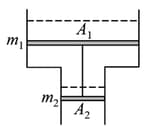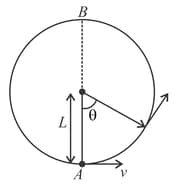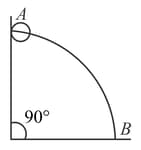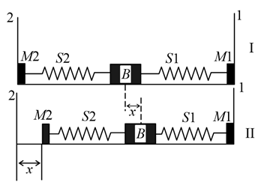A particle free to move along the -axis has potential energy given by, for , where is a positive constant of appropriate dimensions. Then, select the incorrect options.

Important Questions on Work, Energy and Power
Consider a vertical tube open at both ends. The tube consists of two parts, each of different cross-sections and each part having a piston which can move smoothly in respective tubes. The two pistons are joined together by an inextensible wire. The combined mass of the two pistons is and area of cross-section of the upper piston is greater than that of the lower piston. The amount of gas enclosed by the pistons is one mole. When the gas is heated slowly, the pistons moves by as shown in figure. The rise in temperature of the gas is in the form , where is universal gas constant. Use, and outside pressure. Fill value of .

The upper half of an inclined plane with inclination is perfectly smooth, while the lower half is rough. A body starting from rest at the top will again come to rest at the bottom, if the coefficient of friction for the lower half is given by:
A bob of mass is suspended by a massless string of length . The horizontal velocity at position is just sufficient to make it reach the point . The angle at which the speed of the bob is half of that at , satisfies:

A wire, which passes through the hole is a small bead, is bent in the form of a quarter of a circle. The wire is fixed vertically on the ground as shown in the figure. The bead is released from near the top of the wire, and it slides along the wire without friction. As the bead moves from to , the force it applies on the wire is

STATEMENT-:
A block of mass starts moving on a rough horizontal surface with a velocity . It stops due to friction between the block and the surface after moving through a certain distance. The surface is now tilted to an angle of with the horizontal and the same block is made to go up on the surface with the same initial velocity . The decrease in the mechanical energy in the second situation is smaller than that in the first situation.
Because
STATEMENT
The coefficient of friction between the block and the surface decreases with the increase in the angle of inclination.
A block is attached to two unstretched springs and with spring constants and , respectively, (see figure ). The other ends are attached to identical supports and not attached to the walls. The springs and supports have negligible mass. There is no friction anywhere. The block is displaced towards the wall by a small distance (figure ) and released. The block returns and moves a maximum distance towards the wall . Displacements and are measured with respect to the equilibrium position of the block . The ratio is

A light inextensible string that goes over a smooth fixed pulley as shown in the figure connects two blocks of masses (left block) and (right block). Taking , find the work done by the string on the block of mass during the first second after the system is released from rest.

